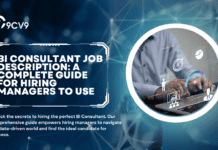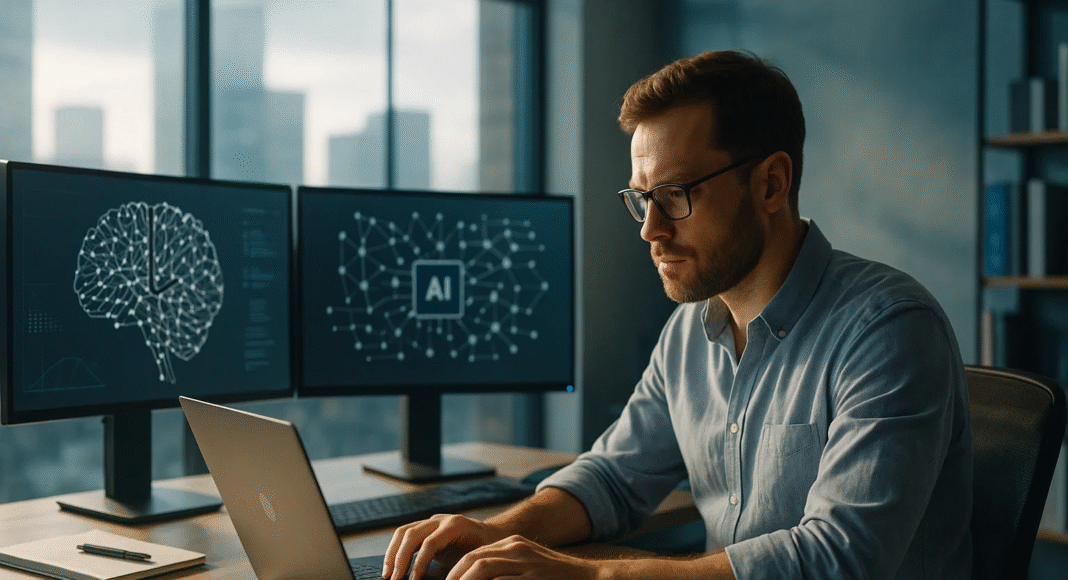Key Takeaways
- AI Architects play a pivotal role in shaping AI strategies, designing scalable solutions, and ensuring business alignment across industries.
- Successful candidates must master a range of technical skills (AI/ML frameworks, programming, cloud computing) and possess strong leadership, communication, and strategic thinking abilities.
- With competitive salaries and growing demand, AI Architecture offers diverse career paths, including senior roles in AI engineering, data science, and software architecture.
In an era where artificial intelligence (AI) is rapidly transforming industries, economies, and everyday life, the role of an AI Architect has emerged as one of the most dynamic and in-demand careers in the technology sector.
As businesses strive to integrate AI-driven solutions into their operations, the need for professionals who can design, develop, and oversee these intelligent systems has grown significantly.
The AI Architect, a pivotal figure at the crossroads of data science, machine learning, and enterprise IT strategy, is now a cornerstone of innovation in digital transformation efforts across the globe.

The surge in AI adoption across sectors such as healthcare, finance, retail, manufacturing, logistics, and cybersecurity has created a fertile ground for AI professionals.
Yet, among the many roles in the AI ecosystem, the AI Architect stands out for their strategic vision, technical depth, and leadership in deploying scalable, intelligent architectures.
These professionals are responsible not just for writing code or training models, but for architecting end-to-end AI solutions that align with an organization’s business objectives, infrastructure capabilities, data ecosystems, and compliance requirements.
This blog delves deep into the multifaceted career of an AI Architect.
From defining what the role entails to exploring the educational and professional pathways that lead to it, we provide a comprehensive overview designed for aspiring AI professionals, career changers, and industry leaders alike.
We examine the scope of the profession in 2025 and beyond, highlighting how advancements in generative AI, edge computing, model governance, and responsible AI are reshaping the responsibilities and opportunities in this field.
We also offer detailed insights into the different specializations an AI Architect can pursue — whether in computer vision, natural language processing, recommendation systems, or AI infrastructure design. The blog outlines the key skills and competencies employers are seeking, the certifications and degrees that can enhance career prospects, and the real-world projects that often define success in this role.
Furthermore, we explore the current hiring landscape, breaking down what to expect in AI Architect interviews, the typical structure of technical and behavioral questions, and how candidates can prepare effectively. Whether you’re targeting roles in startups, tech giants, or enterprise organizations, understanding the expectations at the interview stage is crucial for standing out in a highly competitive talent market.
Lastly, we analyze salary benchmarks for AI Architects across different countries and industries in 2025, helping readers understand the financial rewards that accompany this high-stakes, high-impact role. With demand for AI expertise outpacing supply in many regions, compensation for AI Architects has seen significant growth, making it one of the most lucrative careers in technology today.
If you are curious about the career trajectory of an AI Architect, the learning paths to get there, what recruiters are looking for, and how to unlock the highest earning potential, this blog offers the essential guide you need. Dive in to uncover everything you need to know about becoming and succeeding as an AI Architect in the modern digital economy.
Before we venture further into this article, we would like to share who we are and what we do.
About 9cv9
9cv9 is a business tech startup based in Singapore and Asia, with a strong presence all over the world.
With over nine years of startup and business experience, and being highly involved in connecting with thousands of companies and startups, the 9cv9 team has listed some important learning points in this overview of The Career of an AI Architect: Scope, Description, Paths, Interviews, and Salaries.
If your company needs recruitment and headhunting services to hire top-quality employees, you can use 9cv9 headhunting and recruitment services to hire top talents and candidates. Find out more here, or send over an email to [email protected].
Or just post 1 free job posting here at 9cv9 Hiring Portal in under 10 minutes.
The Career of an AI Architect: Scope, Description, Paths, Interviews, and Salaries
- Scope, Functions, and Strategic Relevance
- Understanding the Multifaceted Role of an AI Architect in 2025
- Exploring the Expansive Role of an AI Architect in 2025
- Mastering the AI Architect Interview Process in 2025
- The Career Landscape of an AI Architect in 2025
- The Role of AI Architects in Project Execution and Strategic Planning in 2025
- Applications, Technologies, and Future Trends
- Skills, Roles, and Future Outlook
1. Scope, Functions, and Strategic Relevance
In 2025, the profession of an AI Architect has ascended to a position of strategic significance within organizations undergoing digital transformation. This role has evolved to embody not only technical mastery but also strategic foresight, business acumen, and a deep understanding of AI ethics and scalability. As enterprises adopt increasingly complex artificial intelligence systems, the AI Architect becomes the linchpin that ensures cohesion, reliability, and alignment between AI initiatives and organizational goals.
Defining the AI Architect: Strategic Functions and Technical Leadership
AI Architects are not merely technical contributors; they are enterprise-level strategists who design the AI backbone of modern organizations.
Core Responsibilities in 2025
- Translating Business Goals into AI Strategies
- Assess organizational needs to determine where AI can drive measurable value.
- Convert high-level corporate objectives into AI blueprints and execution roadmaps.
- Designing Scalable AI Architectures
- Define system components and workflows for AI model deployment at scale.
- Select appropriate frameworks, tools, and infrastructure (cloud, edge, hybrid).
- Oversight of Model Development and Deployment
- Supervise data pipelines, model training environments, and inference engines.
- Integrate models into real-time applications and ensure reliability under load.
- Ensuring Governance and Ethical AI Use
- Implement mechanisms to address data privacy, model interpretability, and bias mitigation.
- Establish AI governance policies to meet regulatory and ethical standards.
- Performance Monitoring and Optimization
- Continuously evaluate the performance of AI systems using KPIs.
- Refine algorithms and systems based on changing inputs and business needs.
AI Architect in the Broader AI-IT Ecosystem
The AI Architect serves as a central orchestrator across cross-functional AI, IT, and business teams.
Collaborative Interfaces Within the Organization
| Role | Collaborative Objective |
|---|---|
| Data Scientists | Coordinate on algorithm selection and model validation. |
| Data Engineers | Ensure robust and scalable data pipelines for AI model consumption. |
| Software Developers | Integrate AI models into front-end and back-end systems. |
| DevOps and IT Ops | Deploy and manage AI systems in production environments securely and efficiently. |
| Cybersecurity Teams | Design safeguards to protect AI pipelines from breaches and adversarial threats. |
| Business Stakeholders | Communicate AI strategy and translate business KPIs into model evaluation metrics. |
| Enterprise Architects | Align AI infrastructure with broader enterprise IT architecture. |
Why the AI Architect Role Is Critical in 2025
- Acts as a bridge between innovation and execution in enterprise AI initiatives.
- Balances systemic design thinking with deep technical fluency.
- Possesses cross-domain fluency, facilitating communication across departments with varying technical literacy.
- Maintains an enterprise-wide perspective, focusing on holistic AI enablement rather than isolated solutions.
Skills, Competencies, and Tools Required in 2025
An AI Architect must exhibit a robust blend of technical, strategic, and interpersonal skills to navigate the complex AI landscape.
Technical Proficiencies
- Advanced knowledge of:
- Machine learning frameworks (TensorFlow, PyTorch)
- Data engineering tools (Apache Spark, Airflow)
- Cloud platforms (AWS, Azure, GCP)
- MLOps pipelines and CI/CD tools (Kubeflow, MLflow)
- Strong understanding of:
- Model deployment strategies (batch, real-time, on-device)
- Data privacy and security protocols (GDPR, HIPAA compliance)
- Edge and distributed AI system design
Strategic and Soft Skills
- Systems thinking for AI deployment at scale
- Business analysis and ROI modeling for AI initiatives
- Communication and stakeholder management
- Leadership in interdisciplinary teams
- Ethical reasoning and responsible AI governance
AI Architect Career Pathways and Industry Relevance
In 2025, the AI Architect career is multi-directional and adaptable, with options to specialize or diversify based on industry demands.
Typical Career Progression
| Stage | Role Example | Focus Area |
|---|---|---|
| Entry Level | Machine Learning Engineer | Model development and data processing |
| Mid-Level | Senior Data Scientist / AI Lead | Solution development, model evaluation |
| Advanced | AI Architect | System design, cross-functional leadership |
| Executive | Head of AI / Chief AI Officer | Strategic planning, enterprise transformation |
Top Industries Hiring AI Architects in 2025
- Healthcare and life sciences
- Fintech and banking
- E-commerce and retail technology
- Manufacturing and supply chain
- Telecommunications and 5G infrastructure
- Government, defense, and smart city projects
Sample AI Architecture: High-Level System Design
Below is a simplified chart showing how an AI Architect might conceptualize an end-to-end system:
┌────────────────────────────┐
│ Business Requirements │
└────────────┬───────────────┘
▼
┌─────────────────────────────┐
│ AI Solution Blueprint │
└────────────┬───────────────┘
▼
┌────────────────────────────┬────────────────────────────┐
│ Data Engineering │ Model Development │
└────────────────────────────┴────────────────────────────┘
▼
┌────────────────────────────┐
│ Model Deployment │
└────────────┬───────────────┘
▼
┌────────────────────────────┐
│ Monitoring & Tuning │
└────────────────────────────┘
Conclusion: Why AI Architects Matter More Than Ever in 2025
As AI technology permeates all aspects of modern enterprise, the AI Architect emerges as a mission-critical professional capable of aligning innovation with strategic business value. These architects are shaping the infrastructure for intelligent decision-making, ethical automation, and competitive differentiation.
They stand at the forefront of technological evolution—blending data science, systems architecture, cloud engineering, and ethical AI design into unified, scalable, and future-proof solutions.
In essence, the AI Architect is not only designing systems but enabling the future of enterprise intelligence.
2. Understanding the Multifaceted Role of an AI Architect in 2025
In 2025, the career of an AI Architect has evolved into one of the most strategically vital and technically demanding roles within the modern digital enterprise. As organizations continue to integrate artificial intelligence across every facet of their operations, the AI Architect stands at the forefront—responsible for engineering intelligent systems that are not only technologically sound but also ethically compliant and business-aligned.
Defining the Role: Strategic Vision Meets Technical Mastery
The AI Architect is far more than a system designer. They are enterprise-level strategists, charged with aligning AI technologies with long-term business objectives.
Core Functions and Strategic Responsibilities
- Translation of Business Goals into AI Blueprints
- Interpret high-level organizational goals to define AI-driven opportunities.
- Develop AI strategies that address business pain points and deliver measurable ROI.
- Architectural Design and Systems Engineering
- Build scalable, modular AI architectures tailored to enterprise needs.
- Ensure interoperability across data pipelines, model deployment frameworks, and infrastructure.
- Technology Stack Curation
- Evaluate and select appropriate AI technologies (e.g., ML frameworks, cloud platforms, DevOps tools).
- Determine integration pathways for legacy systems and emerging AI solutions.
- Oversight of AI Lifecycle Management
- Supervise the entire AI lifecycle: from data acquisition and model training to deployment and monitoring.
- Establish robust versioning, rollback, and governance mechanisms.
- Performance Optimization
- Continuously assess system performance using AI-specific KPIs (latency, accuracy, drift, scalability).
- Iterate model pipelines to enhance efficiency and adaptability.
- Ethical Implementation and Governance
- Integrate fairness, transparency, and accountability into model design.
- Mitigate algorithmic bias, ensure regulatory compliance (e.g., GDPR, AI Act), and enforce responsible AI usage policies.
Essential Traits for Success in 2025
- Deep understanding of enterprise operations and industry-specific use cases.
- Strong communication skills to translate complex AI concepts into business-relevant narratives.
- The ability to balance technical rigor with strategic foresight.
Positioning the AI Architect Within the AI-IT Ecosystem
In the AI-powered enterprise, the AI Architect functions as the central integrator—orchestrating collaboration across a highly interdisciplinary ecosystem.
Key Collaborative Interfaces
| Team/Role | Collaborative Role in AI Projects |
|---|---|
| Data Scientists | Model experimentation, algorithm selection, and metric validation. |
| Data Engineers | Construction and maintenance of data ingestion, transformation, and storage pipelines. |
| Software Engineers | Integration of AI models into applications, APIs, and microservices. |
| IT Operations | Infrastructure provisioning, cloud deployment, and system monitoring. |
| Cybersecurity Experts | Implement AI system defenses, secure model endpoints, and audit data privacy compliance. |
| Business Executives | Define the strategic direction and ROI metrics for AI-driven initiatives. |
| Enterprise Architects | Ensure AI architectures fit within the broader digital infrastructure of the organization. |
Key Integration Responsibilities of the AI Architect
- Act as the technical liaison between data and business domains.
- Coordinate the execution of AI strategies across departments and tools.
- Drive alignment between technical implementations and business KPIs.
Strategic Importance of the AI Architect in 2025
The AI Architect’s importance has expanded in line with the growing complexity of enterprise AI systems.
Why the Role is Business-Critical
- AI systems now function as decision-making engines, not just support tools—demanding governance, explainability, and scalability.
- Digital transformation initiatives rely on AI Architects to design adaptable systems capable of supporting real-time analytics, hyperautomation, and predictive insights.
- AI maturity models place AI Architects at the apex, as they ensure seamless transitions from prototype to production at scale.
Modern AI Architecture: A High-Level Blueprint
A simplified framework of the systems AI Architects design and manage:
┌─────────────────────────────────────────────┐
│ Business Vision & Stakeholder Goals │
└────────────────────────┬────────────────────┘
▼
┌────────────────────────────────┐
│ AI Strategic Roadmap │
└──────────────┬─────────────────┘
▼
┌───────────────┬────────────────────┬────────────────────┐
│ Data Sources │ ML/AI Models │ Infrastructure │
└───────────────┴────────────────────┴────────────────────┘
▼
┌────────────────────────────────┐
│ AI Applications & APIs │
└────────────────────────────────┘
▼
┌────────────────────────────────┐
│ Governance & Monitoring │
└────────────────────────────────┘
Technical and Strategic Competencies for 2025
AI Architects must operate at the confluence of multiple advanced domains.
Technical Toolsets and Frameworks
- AI/ML Tools: TensorFlow, PyTorch, Keras, Scikit-learn
- Data Engineering: Apache Kafka, Airflow, Databricks, Snowflake
- Infrastructure Platforms: AWS Sagemaker, Azure ML, Google Vertex AI
- Deployment Tools: Docker, Kubernetes, MLflow, Kubeflow
- Monitoring & Governance: Prometheus, Grafana, Explainable AI (XAI) frameworks
Strategic and Interpersonal Skills
- Expertise in enterprise data strategy and AI value proposition modeling
- Proficiency in stakeholder engagement and cross-functional team leadership
- Fluency in regulatory compliance, AI governance, and model risk management
Comparative Focus: AI Architect vs. Related Roles
| Role | Primary Focus | Scope | AI Architect’s Distinction |
|---|---|---|---|
| Data Scientist | Model building and experimentation | Narrow and algorithm-specific | Focuses on enterprise-wide AI system architecture |
| Solution Architect | Application-specific architecture | Individual solutions | Designs comprehensive AI platforms organization-wide |
| Enterprise Architect | Overall IT infrastructure strategy | Organization-wide but not AI-specific | Integrates AI-specific layers within broader IT |
Conclusion: The AI Architect as a Visionary Engineer in 2025
In 2025, the AI Architect is no longer a niche role—it is a cornerstone of enterprise transformation. With responsibilities extending beyond software and data engineering, these professionals are tasked with designing the cognitive engines of the digital future. They combine deep technical mastery with strategic insight, operational leadership, and ethical foresight.
As organizations demand more from AI—autonomy, transparency, resilience, and fairness—the AI Architect becomes indispensable in ensuring that intelligent systems are not only operationally robust but also socially and ethically sound. Their work is defining the next generation of enterprise intelligence.
3. Exploring the Expansive Role of an AI Architect in 2025
The role of an AI Architect in 2025 transcends technical execution—it is a strategic, leadership-driven position critical to embedding artificial intelligence into the fabric of modern enterprise operations. These professionals shape the way organizations harness AI, ensuring seamless integration with business objectives, ethical standards, and evolving technological ecosystems.
Comprehensive Job Scope and Daily Responsibilities of an AI Architect
AI Architects function as both technical strategists and execution leaders, guiding the development and deployment of intelligent systems that drive enterprise innovation.
Core Functional Areas
- AI Solution Design & Implementation
- Architect scalable AI systems using state-of-the-art frameworks and cloud-native technologies.
- Align technical architectures with long-term organizational strategies and KPIs.
- Development of AI-Driven Applications
- Collaborate with software engineers and data scientists to design intelligent applications using relevant APIs.
- Oversee end-to-end AI application development, from proof-of-concept to production-grade deployment.
- Strategic Alignment and Business Translation
- Translate broad business objectives into specific, actionable AI use cases.
- Ensure all AI models and initiatives generate measurable business value.
- Data Infrastructure and Model Reliability
- Design robust data architectures that support predictive modeling and real-time analytics.
- Develop high-performance AI models that deliver reliable outcomes in live environments.
- AI Lifecycle Management
- Monitor model performance post-deployment and implement continuous learning mechanisms.
- Integrate versioning, testing, and governance protocols throughout the ML lifecycle.
- Collaboration and Team Leadership
- Direct and mentor multidisciplinary AI teams, fostering a culture of innovation.
- Lead agile project cycles and ensure timely, cost-effective delivery of AI initiatives.
- Security, Ethics, and Compliance Oversight
- Identify risks related to model bias, data privacy, and adversarial attacks.
- Enforce responsible AI frameworks and maintain alignment with regulatory mandates.
Strategic Deliverables
| Area | Responsibilities |
|---|---|
| AI Strategy Development | Define AI roadmaps, implementation phases, and scaling frameworks. |
| Model Governance | Audit existing models and development practices for quality control. |
| Enterprise Integration | Ensure AI solutions work harmoniously with legacy IT systems. |
| Innovation Monitoring | Track emerging AI trends and integrate relevant innovations. |
Essential Technical Skill Set for AI Architects in 2025
In an era where AI is central to enterprise evolution, AI Architects are expected to master a sophisticated and ever-expanding technical toolkit.
Core Technical Domains
- Programming Languages
- Expertise in Python, R, and Java for model development, scripting, and system integration.
- Machine Learning & AI Frameworks
- Proficiency in TensorFlow, PyTorch, Keras, Scikit-learn for building and training intelligent systems.
- Big Data and Processing Tools
- Familiarity with Apache Spark, Hadoop, and Kafka for handling large-scale, real-time data.
- Cloud AI Platforms
- In-depth experience with:
- AWS (e.g., Sagemaker, Rekognition)
- Azure (e.g., Azure ML, Cognitive Services)
- Google Cloud (e.g., Vertex AI, AutoML)
- In-depth experience with:
- Model Deployment and Orchestration
- Use of Docker and Kubernetes for containerization and orchestration of AI services.
- Integration with CI/CD pipelines for continuous deployment and testing.
- Natural Language Processing (NLP)
- Application of NLP libraries such as SpaCy, Hugging Face Transformers, and NLTK for language-based models.
- Data Governance and Compliance
- Knowledge of GDPR, AI Act, and enterprise-level data privacy and security protocols.
Technical Proficiency Table
| Technical Area | Required Tools & Skills |
|---|---|
| Programming | Python, Java, R |
| AI Frameworks | TensorFlow, PyTorch, Keras, Scikit-learn |
| Cloud Platforms | AWS, Azure, GCP AI Services |
| Data Processing | Hadoop, Spark, Kafka |
| Deployment & Orchestration | Docker, Kubernetes, MLflow, Kubeflow |
| NLP | Transformers, SpaCy, NLTK, GPT-based APIs |
| Governance | Audit frameworks, data compliance, MLOps toolchains |
Crucial Non-Technical Competencies for AI Architects
While technical expertise forms the backbone of the AI Architect’s capabilities, it is the non-technical skills that elevate their influence and effectiveness in an organizational setting.
Leadership & Strategic Execution
- Lead cross-functional teams including data scientists, engineers, and business analysts.
- Drive enterprise-wide AI adoption strategies and innovation programs.
Project Management and Communication
- Ensure AI initiatives are delivered on schedule, within scope, and aligned to business objectives.
- Communicate complex AI solutions clearly to non-technical executives and stakeholders.
Ethical Oversight and Risk Mitigation
- Address concerns around data misuse, algorithmic bias, and societal implications of AI.
- Embed ethical frameworks into all AI design and deployment practices.
Analytical and Problem-Solving Skills
- Apply systems thinking to solve complex problems with multi-dimensional variables.
- Evaluate AI techniques and approaches based on scalability, performance, and ethical feasibility.
Adaptability and Thought Leadership
- Continuously learn and adapt to new AI models, regulations, and development methodologies.
- Champion AI literacy and best practices across the organization.
Key Soft Skills Overview
| Competency Area | Description |
|---|---|
| Communication | Ability to explain AI concepts to non-technical stakeholders |
| Strategic Thinking | Aligning AI initiatives with broader business goals |
| Leadership | Mentoring AI teams and influencing C-suite decision-makers |
| Ethics & Compliance | Ensuring alignment with global regulatory and fairness standards |
| Innovation Agility | Adapting to rapid shifts in AI technology and methodologies |
| Risk Management | Identifying and mitigating technical and ethical risks in AI projects |
Summary: The Evolving Career of the AI Architect in 2025
By 2025, the AI Architect has emerged as a pivotal figure in enterprise transformation. No longer confined to technical domains, these professionals shape AI ecosystems that are resilient, ethical, and aligned with strategic business objectives. Their success depends equally on deep technical fluency and strong leadership acumen.
Organizations increasingly rely on AI Architects to deliver:
- Scalable, production-ready AI platforms.
- Responsible innovation through AI governance.
- Strategic foresight that turns AI into a business growth driver.
As AI technologies mature and enterprise reliance intensifies, the demand for professionals who can architect intelligent, compliant, and mission-critical systems will only grow. The AI Architect, therefore, is not just a technical role—it is a strategic linchpin in the future of business intelligence.
4. Mastering the AI Architect Interview Process in 2025
As organizations continue to scale their artificial intelligence capabilities, the role of the AI Architect has evolved into a highly strategic and technically demanding leadership position. Preparing for an interview in this field requires a well-rounded understanding of advanced AI concepts, robust system design methodologies, and strategic business alignment. This guide explores the multifaceted nature of AI Architect interviews in 2025.
Types of Interview Questions: What to Expect
AI Architect interviews typically include a combination of technical deep-dives, strategic reasoning scenarios, and behavioral assessments.
Core Interview Areas:
- Architectural Decision-Making:
- Candidates may be asked to describe how they designed scalable and maintainable AI architectures.
- Expect scenarios comparing the suitability of different ML models (e.g., decision trees vs. deep learning).
- Business Alignment:
- Demonstrating how AI solutions align with long-term enterprise goals is a frequent focus.
- Interviewers may probe strategies used to translate high-level business problems into actionable AI use cases.
- Bias and Model Ethics:
- Strong emphasis is placed on handling bias mitigation techniques and promoting ethical AI development.
- Questions often cover techniques to ensure fairness, such as reweighting, adversarial de-biasing, or audit trails.
- Communication and Stakeholder Engagement:
- Candidates are often required to explain AI systems to non-technical executives.
- Sample questions include how to pitch an AI project to C-level leadership or respond to skepticism about algorithmic decisions.
- Problem Solving and Troubleshooting:
- Common inquiries include handling model performance failures, managing imbalanced datasets, and addressing explainability issues in deployed systems.
- Leadership and Innovation:
- Candidates may be asked about mentoring teams, managing cross-functional AI projects, and leading complex integrations across business units.
Deep Dive: Technical Interview Themes
AI Architect candidates are expected to demonstrate fluency across AI theory, frameworks, model training, and deployment pipelines.
Common Technical Topics:
- AI Fundamentals:
- Explain AI types (reactive, limited memory, theory of mind, self-aware).
- Contrast machine learning and traditional programming.
- Model Architecture:
- Discuss CNNs, RNNs, GANs, and Transformer-based models.
- Explain techniques for reducing overfitting and boosting model generalizability.
- Responsible AI:
- Define model bias and fairness.
- Explain how model explainability is ensured using LIME, SHAP, or interpretable neural architectures.
- Mathematics & Algorithms:
- Cover topics like eigenvalues, PCA, optimization functions, and regularization techniques.
- Describe the role of Markov Decision Processes and Q-Learning in reinforcement learning.
- Deployment & MLOps:
- Discuss experience with tools such as TensorFlow Serving, MLFlow, Docker, and Kubernetes.
- Explain CI/CD workflows for AI pipelines in hybrid or multi-cloud environments.
Sample Knowledge Table:
| Category | Key Focus Areas | Tools & Frameworks |
|---|---|---|
| Model Development | CNNs, GANs, Bias Mitigation | PyTorch, TensorFlow, scikit-learn |
| AI Ethics | Explainability, Bias, Fairness | LIME, SHAP, AIF360 |
| Infrastructure & MLOps | Scalable Deployment, Model Monitoring | AWS Sagemaker, MLflow, Kubernetes |
| Data Engineering | ETL, Feature Engineering, Governance | Spark, Kafka, Airflow |
| Advanced Techniques | Reinforcement Learning, NLP, Time-Series | Q-Learning, Transformers, BERT, GPT |
Navigating Behavioral and Leadership Assessments
Behavioral interviews assess how candidates manage teams, address uncertainty, and collaborate across organizational boundaries.
Key Behavioral Themes:
- Design Thinking in AI:
- Share experiences on initiating an AI project from client consultation to final delivery.
- Discuss how user requirements were integrated into model and system architecture.
- Stakeholder Management:
- Questions may probe conflict resolution with clients or internal teams.
- Scenario-based inquiries may include explaining delays in AI model deployment to executives.
- Adaptability & Continuous Learning:
- Candidates should articulate how they stay informed about emerging technologies such as generative AI or neuro-symbolic architectures.
- Sustainability & Compliance:
- Explain how models were designed to align with evolving AI regulations (e.g., GDPR, AI Act).
- Describe efforts to reduce compute costs and energy consumption during model training.
System Design Challenges in the AI Domain
System design rounds are increasingly complex, requiring candidates to design full-scale AI systems under constraints of scale, cost, and security.
Common Design Scenarios:
- Scalability and Cost Management:
- How to design an AI pipeline for dynamic workloads using Kubernetes and serverless architecture.
- Architecture Optimization:
- Selection between batch processing vs. streaming for real-time inference models.
- Cloud-Native AI Deployment:
- Designing solutions optimized for AWS, Azure, or GCP environments with built-in observability and compliance.
- Data Privacy and Security:
- Integration of federated learning and differential privacy to protect sensitive data.
Example System Design Flowchart:
User Request → API Gateway → Data Preprocessing (Kafka + Spark) →
Model Inference (TensorFlow + Flask on Kubernetes) →
Post-Processing → Database → Dashboard/API Response
Machine Learning-Specific Technical Evaluations
Interviewers expect candidates to possess in-depth knowledge of advanced ML techniques and their practical implementation.
Advanced ML Topics to Prepare:
- Reinforcement Learning:
- Explain Q-Learning, Policy Gradients, Markov Decision Processes.
- Application examples in recommendation systems or robotics.
- Fuzzy Logic & Probabilistic Models:
- Describe real-world use cases for fuzzy logic in uncertain environments.
- Explain usage of Hidden Markov Models in speech and anomaly detection.
- Dimensionality Reduction:
- Discuss PCA and the role of eigenvectors/eigenvalues.
- Use cases for feature extraction in large-scale datasets.
- Model Evaluation:
- Articulate performance metrics beyond accuracy—precision, recall, ROC-AUC, F1-Score.
- Discuss cross-validation and techniques like grid search, Bayesian optimization.
Conclusion: Positioning for Success as an AI Architect in 2025
To succeed in an AI Architect interview in 2025, candidates must demonstrate mastery across a broad spectrum of technical and strategic domains. This includes:
- Deep theoretical understanding and real-world experience with AI frameworks.
- The ability to align technology decisions with measurable business impact.
- A strong grasp of compliance, security, and ethics in AI systems.
- Leadership capabilities and effective communication with both technical and executive stakeholders.
AI Architect interviews are not solely about showcasing technical depth—they are a rigorous evaluation of a professional’s capability to drive AI-driven transformation in modern enterprises.
5. The Career Landscape of an AI Architect in 2025
As artificial intelligence matures and becomes central to enterprise transformation strategies, the role of the AI Architect has emerged as a pivotal position in technology organizations. These professionals are not only technical visionaries but also strategic enablers who ensure AI deployments align with business goals, comply with ethical standards, and scale efficiently across distributed infrastructures. The career of an AI Architect in 2025 offers a spectrum of opportunities, from entry-level transitions to executive leadership roles and cross-domain specializations.
Entry Pathways: Foundational Roles Leading to AI Architecture
The journey to becoming an AI Architect is typically preceded by years of experience in adjacent technical roles that lay the groundwork in data science, machine learning, and software design.
Common Starting Positions:
- AI Engineer
- Builds, trains, and optimizes AI/ML models.
- Works extensively with neural networks, supervised learning, and deep learning frameworks.
- Machine Learning Engineer
- Designs end-to-end ML pipelines, including feature extraction, training, and evaluation.
- Often collaborates with DevOps and Data Engineering teams.
- Data Scientist
- Focuses on extracting actionable insights from large datasets.
- Frequently contributes to algorithm development and model validation.
- Software Architect with AI Focus
- Designs software systems with integrated AI components.
- Applies architectural principles to ensure scalable and secure deployments.
Essential Skill Foundations:
- Strong grasp of computer science fundamentals:
- Data structures and algorithms
- Object-oriented design
- Distributed computing
- Proficiency in AI/ML platforms and frameworks:
- TensorFlow, PyTorch, Scikit-learn
- Spark, Kubernetes, MLflow
- Academic background in:
- Computer Science, Artificial Intelligence, or related disciplines
- Advanced mathematics including linear algebra, statistics, and calculus
Career Advancement and Specialization Opportunities
Once in an AI Architect role, professionals can take multiple trajectories based on their technical interests, leadership aspirations, or domain-specific expertise.
Career Progression Paths:
- AI Systems Architect → Principal AI Architect
- Leads enterprise-level AI strategies and technical roadmaps.
- Mentors engineering teams and influences organizational architecture standards.
- AI Solution Architect → Lead Solutions Architect
- Focuses on delivering AI-driven business solutions.
- Bridges technical execution with stakeholder expectations and ROI tracking.
- CTO/Chief AI Architect
- Guides AI strategy across the organization.
- Aligns AI initiatives with product vision, compliance mandates, and long-term growth.
Cross-Domain Specialization Avenues:
- Industry-Specific Expertise:
- Healthcare AI: Focus on diagnostics, clinical NLP, and patient data privacy.
- Finance AI: Specialize in fraud detection, algorithmic trading, and risk scoring.
- Retail AI: Drive customer personalization, inventory forecasting, and supply chain optimization.
- Technical Specialization:
- Natural Language Processing (NLP): Architect systems for chatbots, sentiment analysis, and summarization.
- Computer Vision: Build frameworks for object detection, facial recognition, and surveillance.
- Robotics & IoT: Design AI pipelines for autonomous decision-making and edge AI devices.
- Strategic Consulting Roles:
- Transition into roles as AI Strategy Consultant or AI Transformation Advisor.
- Advise multiple enterprises on large-scale AI implementation, compliance, and organizational change.
Comparative Role Analysis: Distinguishing AI Architect from Related Positions
Understanding how the AI Architect role differs from adjacent positions helps professionals refine their career paths and organizations define hiring strategies more effectively.
Role-Based Comparison Table:
| Role | Primary Focus Area | Key Differentiator |
|---|---|---|
| AI Architect | Design and integration of scalable AI systems | Oversees system-wide AI infrastructure and architecture |
| AI Engineer | Hands-on development of AI models | Focuses on implementation of specific ML models |
| AI Developer | Application development with AI capabilities | Builds applications that consume AI services |
| Software Architect (AI) | General software architecture with AI elements | Broader software design; not solely AI-centric |
| Network Architect | Design of networking infrastructure | Focuses on connectivity, not AI frameworks |
| Senior Data Architect | Data modeling and data pipeline architecture | Ensures data readiness for AI consumption |
| Generative AI Architect | Architecting systems for generative AI models | Specializes in LLMs, GANs, and generative transformers |
AI Architect Salary Insights in 2025 (U.S. Market Overview)
The compensation for AI Architects reflects both the technical complexity of the role and its strategic value to organizations. In 2025, AI Architects continue to rank among the highest-paid professionals in the tech industry.
Key Compensation Highlights:
- Entry-Level Professionals:
- Typically earn between $90,000 and $130,000 annually.
- Often transitioning from ML engineering or data science backgrounds.
- Mid-Level AI Architects:
- Average compensation ranges from $128,756 to $181,500.
- Salaries influenced by domain experience, certification, and project leadership.
- Senior and Experienced AI Architects:
- Salaries may reach $204,300 to $234,900.
- Include bonuses, stock options, and leadership responsibilities.
- Top Earners in High-Stakes Industries (e.g., finance, defense):
- Annual compensation can exceed $250,000 to $300,000+.
U.S. AI Architect Salary Range by Experience Level
| Experience Level | Minimum Annual Salary | Average Salary Range | Maximum Potential Salary |
|---|---|---|---|
| Entry-Level | $90,000 | $130,000 – $170,001 | – |
| Mid-Level | – | $128,756 – $181,500 | – |
| Experienced | – | $160,000 – $200,000 | $204,300 – $234,900 |
| Executive / Top 10% | – | – | $250,000 – $300,000+ |
Data Sources:
- Glassdoor reports total compensation of ~$181,197/year, including $130,053 in base salary and $51,144 in bonuses/profit sharing.
- Talent.com estimates average U.S. AI Architect salary at $173,000/year, reflecting a growing demand for cross-disciplinary AI leadership.
Conclusion: A High-Impact, High-Reward Career Path
In 2025, the role of the AI Architect is positioned at the intersection of cutting-edge technology, ethical governance, and enterprise strategy. Professionals pursuing this career are expected to:
- Combine deep technical expertise with architectural foresight.
- Navigate regulatory landscapes and ensure ethical AI deployment.
- Communicate fluently with both technical teams and business leaders.
- Continuously upskill in areas such as generative AI, secure deployment, and AI governance frameworks.
The career trajectory for AI Architects is not only financially rewarding but also offers opportunities for innovation, influence, and industry leadership. As artificial intelligence continues to redefine industries, AI Architects will remain central to shaping the next generation of intelligent systems.
6. The Role of AI Architects in Project Execution and Strategic Planning in 2025
Strategic Involvement Across the AI Project Lifecycle
AI Architects hold a critical position throughout the entirety of an AI project’s lifecycle. Their influence extends from strategic conception to operational deployment.
- Initial Planning Phase
- Collaborate with C-suite executives and stakeholders to align AI initiatives with business goals.
- Define strategic objectives, key results, and the expected value of AI integration.
- Requirements Gathering and Analysis
- Analyze enterprise challenges to identify AI-driven opportunities.
- Translate business problems into technically feasible AI solutions.
- Solution Design and System Architecture
- Develop high-level architecture blueprints including data flow pipelines, model development environments, deployment layers, and integration strategies.
- Select optimal technologies, tools, and frameworks tailored to the project’s scale and domain.
- Data Strategy and Preparation
- Design data acquisition, preprocessing, and transformation pipelines.
- Ensure data integrity and relevance for model training and inference.
- Model Development Oversight
- Supervise data science and ML teams during experimentation and model tuning.
- Ensure models are robust, scalable, and aligned with project objectives.
- Deployment and Maintenance
- Oversee integration with enterprise systems.
- Implement monitoring solutions to track system health, model accuracy, and performance.
- Facilitate ongoing model improvement through performance audits and retraining.
Cross-Functional Collaboration and Communication
Effective teamwork and interdisciplinary coordination are essential aspects of the AI Architect’s daily function.
- Key Team Collaborations
- Work with data engineers on infrastructure scalability and data pipelines.
- Guide software developers in integrating AI models into applications.
- Communicate with cybersecurity teams to ensure compliance and security.
- Bridge communication between technical experts and business stakeholders.
- Interpersonal Skills
- Translate complex technical jargon into business language.
- Lead multi-functional teams with strategic direction and project milestones.
- Actively collect and incorporate feedback from various departments.
Strategic Planning and Technology Decision-Making
AI Architects play a central role in shaping the organization’s AI agenda.
- AI Strategy Development
- Identify future AI trends relevant to the business.
- Prioritize projects based on potential ROI and alignment with business roadmaps.
- Technology Selection and Evaluation
- Assess the maturity and compatibility of emerging tools.
- Choose platforms that offer scalability, cloud-native capabilities, and integration with existing ecosystems.
- Architectural Governance
- Establish standards for model transparency, interpretability, and data governance.
- Balance innovation with practicality, budget, and compliance.
Time Allocation and Daily Responsibilities
AI Architects must adeptly manage time across strategic, design, and operational duties.
| Task Category | Estimated Time Allocation (%) |
|---|---|
| Strategic Planning and Roadmapping | 20% |
| System Design and Architecture | 25% |
| Oversight of Model Development | 15% |
| Technology Evaluation and Tooling | 10% |
| Cross-functional Collaboration | 20% |
| Monitoring, Security, and Maintenance | 10% |
- Leverage automation to streamline repetitive tasks such as monitoring and model retraining.
- Prioritize high-impact activities that directly influence project outcomes and business KPIs.
Scope and Duration of AI Projects
AI project timelines are influenced by the problem complexity, model maturity, and data readiness.
- Project Scale
- Small-scale pilots: 2 to 4 months.
- Mid-sized solutions: 4 to 7 months.
- Enterprise-wide deployments: 6 to 12+ months.
- Project Lifecycle Phases
- Problem Definition: Identify business pain points.
- Data Preparation: Collect, clean, and transform data (can consume 60-80% of project time).
- Model Training and Validation: Build and fine-tune algorithms.
- Deployment and Integration: Embed models into production environments.
- Monitoring and Continuous Improvement: Update models based on feedback.
| AI Project Stage | Average Duration (weeks) |
| Business Use Case Scoping | 2 – 4 |
| Data Processing & Prep | 4 – 12 |
| Model Development | 6 – 10 |
| Deployment & Testing | 3 – 6 |
| Monitoring & Optimization | Ongoing |
Key Performance Metrics for Success Evaluation
Measuring success in AI projects involves both technical and business-aligned KPIs.
- System Performance Metrics
- Uptime (% of system availability)
- Model latency (response time per request)
- Error rate (failures per 1,000 requests)
- Token/request throughput for LLMs
- Business Impact Metrics
- Revenue uplift from AI deployment
- Time-to-Value (TTV)
- Net Promoter Score (NPS) and Customer Satisfaction (CSAT)
- Employee productivity gains
- Model Performance Metrics
- Accuracy, Precision, Recall, F1 Score
- AUC-ROC (for classification)
- Mean Absolute Error (MAE, for regression)
- User Engagement Metrics
- Adoption rate of AI tools
- Frequency of usage and average session duration
- User feedback (e.g., qualitative reviews, satisfaction scores)
Conclusion
The role of AI Architects in 2025 is distinguished by its strategic depth, technical breadth, and high impact on business transformation. With responsibilities ranging from conceptualizing AI strategies to leading cross-functional teams and ensuring successful deployments, AI Architects are indispensable assets for organizations striving to remain competitive in the AI-driven digital economy.
7. Applications, Technologies, and Future Trends
Diverse Applications and Project Types in AI Architecture
As artificial intelligence becomes increasingly embedded across industries, AI Architects are tasked with designing and overseeing an expansive variety of projects that blend business value with technical precision.
Industry-Specific Implementations:
- Architecture & Construction (AEC):
- Generative design for exploring structural alternatives based on input constraints.
- Automated generation of 3D models and schematic drawings.
- AI-assisted site planning, zoning analysis, and compliance checks.
- Smart city modeling using predictive analytics and real-time data feeds.
- Structural integrity simulations using machine learning for stress analysis.
- Creative and Media Industries:
- Text-to-image and text-to-video generation through generative adversarial networks (GANs).
- Speech synthesis and voice cloning using deep neural networks.
- AI-curated content development, including automated scriptwriting and article summarization.
- Enterprise & Business Operations:
- Sentiment analysis for brand monitoring and customer experience enhancement.
- Predictive analytics for demand forecasting, fraud detection, and churn prediction.
- Recommender systems that personalize user journeys on e-commerce and streaming platforms.
- Automotive & Industrial:
- AI-driven predictive maintenance to reduce equipment downtime.
- Edge AI integration in autonomous vehicles for real-time decision-making.
- Robotic process automation (RPA) combined with AI for manufacturing process control.
- Healthcare & Life Sciences:
- Medical image classification using convolutional neural networks (CNNs).
- Predictive diagnostics for disease outbreaks using real-time sensor data.
- AI-powered drug discovery through bioinformatics and molecular simulations.
Generative AI in Practice:
- Creation of unique text, images, music, and code.
- Translation of natural language to SQL or Python code for data querying and automation.
- Conversational AI interfaces enhancing virtual assistant capabilities.
Table: Popular AI Use Cases by Industry
| Industry | AI Applications | Business Impact |
|——————-|————————————————–|———————————————|
| Architecture | Generative design, 3D modeling, smart planning | Faster iteration, cost efficiency |
| E-commerce | Recommender systems, customer insights | Increased conversion, user engagement |
| Healthcare | Diagnostics, genomics, image analysis | Improved accuracy, faster diagnostics |
| Manufacturing | Predictive maintenance, RPA | Reduced downtime, operational efficiency |
| Media & Content | Content generation, language modeling | Scalable personalization, creative scaling |
The AI Architect’s Toolkit: Technologies and Frameworks
An AI Architect’s effectiveness is defined not only by vision but also by mastery of a diverse, evolving technological stack.
Key Software Frameworks:
- Machine Learning & Deep Learning:
- TensorFlow: High-performance AI model development.
- PyTorch: Dynamic computation graphs, favored for research and production.
- Keras: Simplified model building atop TensorFlow.
- scikit-learn: Classical ML for regression, classification, and clustering tasks.
- Big Data & Stream Processing:
- Apache Spark: Distributed computing for ML pipelines.
- Kafka: Real-time data ingestion for AI systems.
- Cloud & Infrastructure Platforms:
- AWS SageMaker, Azure ML, Google Vertex AI: Scalable model training, deployment, and MLOps.
- Docker & Kubernetes: Containerization and orchestration for scalable, reliable AI environments.
- Hardware Accelerators:
- GPUs (e.g., NVIDIA A100) and TPUs: Optimized computation for deep learning tasks.
- Programming Languages:
- Python: Primary language for AI development.
- R: Statistical computing and data visualization.
- Java: High-performance, scalable backend AI systems.
Chart: Technology Usage Among AI Architects (2025 Projection)
- Python: 98%
- TensorFlow/PyTorch: 87%
- Cloud ML Services: 84%
- Docker/Kubernetes: 75%
- Big Data Tools: 69%
Future Trends in AI Architecture and Innovation
AI in 2025 is at the brink of several paradigm-shifting trends, and AI Architects are expected to lead innovation at this frontier.
Emerging Technological Shifts:
- Hybrid AI Systems:
- Combines symbolic AI with machine learning for enhanced decision-making.
- Enables explainability and reasoning in complex environments.
- Edge AI:
- Executes AI models on devices (IoT, wearables) for instant insights without relying on cloud latency.
- Critical in autonomous vehicles, smart factories, and remote healthcare.
- Multi-Agent Systems (MAS):
- AI agents collaborating autonomously for logistics, robotics, and smart infrastructure.
- Useful in simulations, swarm intelligence, and decentralized AI.
- Generative Design & Sustainable Architecture:
- AI-driven creation of eco-efficient building models optimized for energy, space, and materials.
- Contributes to carbon neutrality goals in urban planning.
- AI for Smart Cities:
- Traffic flow optimization, predictive utility management, and real-time environmental monitoring.
- Supports governments in building data-driven urban infrastructure.
Strategic Responsibilities for Architects:
- Anticipating AI integration into core business systems.
- Advocating ethical AI usage and transparency.
- Establishing AI Centers of Excellence (CoE) to institutionalize innovation.
- Designing models with regulatory compliance (GDPR, AI Act) from inception.
The Continuous Learning Imperative
The rapidly advancing AI landscape necessitates that AI Architects continually evolve to maintain relevance and competitive edge.
Learning Priorities:
- Staying abreast of emerging AI paradigms such as quantum machine learning and neuro-symbolic AI.
- Participating in global AI conferences, certifications (e.g., Google Cloud ML Engineer, Azure AI Engineer), and advanced degrees.
- Engaging in interdisciplinary learning—combining AI with cybersecurity, ethics, law, and business strategy.
Certifications and Learning Platforms:
| Certification | Provider | Focus Area |
|---|---|---|
| Google Professional ML Engineer | Google Cloud | Cloud-based AI deployment |
| Microsoft Certified: Azure AI Engineer | Microsoft Azure | Cognitive services, bots, ML ops |
| TensorFlow Developer Certificate | TensorFlow.org | Deep learning model development |
| IBM AI Engineering Professional | Coursera/IBM | Full AI lifecycle and tools |
Conclusion: Strategic Importance of AI Architects in 2025
In 2025, AI Architects occupy a critical role at the nexus of technology innovation, business transformation, and ethical AI deployment. Their responsibilities now transcend pure technical execution to include:
- Strategic foresight into AI’s business value.
- Tactical leadership across multidisciplinary teams.
- Continuous innovation aligned with emerging technologies.
- Long-term planning for AI sustainability, scalability, and compliance.
With AI continuing to reshape industries, the demand for AI Architects is poised for sustained growth—making this one of the most strategic and high-impact roles in the future of work.
8. Skills, Roles, and Future Outlook
Overview: The Strategic Importance of AI Architects
In 2025, the role of an AI Architect represents a strategic cornerstone in the enterprise adoption of artificial intelligence. Operating at the confluence of advanced technological design and business strategy, AI Architects are tasked with translating organizational goals into scalable, ethical, and high-impact AI systems.
Key Role Characteristics:
- Acts as a bridge between data scientists, engineers, and business leaders.
- Leads the design, deployment, and governance of AI systems aligned with operational objectives.
- Guides organizations through the complexities of AI ethics, compliance, and security.
Technical and Non-Technical Proficiencies Required
To thrive in this highly specialized domain, AI Architects must possess a sophisticated blend of technical mastery and interpersonal capabilities. The role goes beyond engineering—it demands strategic foresight and organizational alignment.
Core Technical Skills:
- Programming Languages:
- Python (for machine learning pipelines)
- Java (for backend integration)
- R (for statistical modeling)
- AI/ML Frameworks:
- TensorFlow and PyTorch for neural network development
- Keras for rapid prototyping
- Scikit-learn for traditional ML algorithms
- Cloud Platforms & DevOps Tools:
- AWS SageMaker, Google Cloud AI, Azure ML for deployment
- Kubernetes and Docker for containerized model orchestration
- CI/CD pipelines for continuous model delivery
- Big Data Ecosystem:
- Apache Spark, Kafka, and Hadoop for processing and real-time analytics
Essential Non-Technical Competencies:
- Strategic Communication: Translating AI insights into actionable business language.
- Leadership & Collaboration: Managing cross-functional teams and stakeholders.
- Ethical Reasoning: Ensuring responsible use of AI in line with regulatory standards.
- Problem Solving: Addressing multifaceted issues spanning data, design, and deployment.
The Role Within the AI Project Lifecycle
AI Architects serve as end-to-end orchestrators in AI initiatives. Their involvement spans from initial conceptualization through operationalization and ongoing performance optimization.
Responsibilities Across the Lifecycle:
- Strategic Planning:
- Assess business objectives and data readiness.
- Define KPIs and success metrics for AI solutions.
- System Design:
- Architect AI pipelines using microservices and cloud infrastructure.
- Select appropriate models and algorithms based on application needs.
- Deployment & Monitoring:
- Ensure scalable deployment of models via cloud or edge environments.
- Implement performance monitoring and model retraining workflows.
- Governance & Compliance:
- Oversee explainability, fairness, and auditability of AI outputs.
- Align deployments with global standards like the EU AI Act or ISO/IEC 42001.
Interview Process and Hiring Expectations
Entering the AI Architecture domain typically involves a rigorous selection process focused on both depth and breadth of capability.
Interview Focus Areas:
- System Design: Architecture of scalable, distributed AI platforms.
- Machine Learning Concepts: Deep understanding of supervised, unsupervised, and reinforcement learning.
- Behavioral Assessment: Team leadership, decision-making, and communication under pressure.
- Problem-Solving Scenarios: Case studies simulating real-world deployment challenges.
Table: AI Architect Interview Format (Typical Breakdown)
| Interview Stage | Key Focus Area | Weightage (%) |
|---|---|---|
| Technical Screening | Coding, algorithms, ML theory | 30% |
| Architecture Round | System and ML pipeline design | 30% |
| Behavioral Interview | Communication, leadership, teamwork | 20% |
| Case Study Presentation | Real-world AI design simulation | 20% |
Career Pathways and Advancement Opportunities
The trajectory of an AI Architect typically evolves from core technical roles to strategic leadership positions, offering specialization across emerging domains.
Typical Career Progression:
- Entry-Level Roles:
- AI/ML Engineer
- Data Scientist
- Software Engineer (AI-focused)
- Mid-Level:
- AI Solution Architect
- ML Platform Engineer
- AI Research Lead
- Advanced Roles:
- Chief AI Officer (CAIO)
- Director of AI Strategy
- AI Governance and Ethics Lead
Compensation and Global Demand in 2025
Given the advanced expertise and cross-functional responsibilities, AI Architects command highly competitive salaries, particularly in developed economies and tech hubs.
Table: Average Annual Salary for AI Architects (2025 Estimates)
| Region | Entry-Level (USD) | Mid-Level (USD) | Senior-Level (USD) |
|---|---|---|---|
| United States | $120,000 | $160,000 | $200,000+ |
| Western Europe | €85,000 | €115,000 | €150,000+ |
| Middle East (e.g., UAE) | $90,000 | $120,000 | $160,000+ |
| Southeast Asia | $60,000 | $85,000 | $120,000+ |
Salaries vary based on industry specialization, experience, and location.
Future Trends Shaping AI Architecture
As the field evolves, several transformative trends are reshaping the expectations and capabilities required of AI Architects in 2025.
Technological Directions:
- Hybrid AI Systems:
- Integrating symbolic logic with ML for interpretable, reliable AI.
- Edge AI:
- Decentralized intelligence in autonomous vehicles, IoT devices, and manufacturing units.
- Neuro-Symbolic AI:
- Combining neural networks with human-like reasoning capabilities.
Design Innovations:
- Generative Design:
- AI-powered tools exploring thousands of configurations in product and architectural design.
- Sustainable AI:
- Focus on energy-efficient model training and carbon-neutral AI deployment.
Governance Trends:
- AI Ethics and Trustworthiness:
- Demand for explainable AI (XAI), fairness audits, and responsible AI frameworks.
- Global Compliance Mandates:
- Navigating cross-border AI regulations including GDPR, the AI Act, and data sovereignty laws.
Chart: Future Trends Impacting AI Architects (2025–2030)
- Hybrid AI
- Edge Computing
- XAI (Explainable AI)
- AI Ethics & Policy
- Generative Systems
- Sustainable Infrastructure
Conclusion: A Rewarding and Strategic Career Path
The career of an AI Architect in 2025 is characterized by complexity, influence, and innovation. It demands a harmonious integration of deep technical proficiency, strategic insight, and ethical leadership.
Key Takeaways:
- AI Architects are central to enterprise innovation and transformation.
- The role encompasses full lifecycle oversight of AI systems.
- Continuous upskilling is essential to adapt to evolving tools, frameworks, and governance.
- Demand is rising globally, offering lucrative compensation and leadership opportunities.
For individuals with a passion for artificial intelligence and a desire to architect the future of intelligent systems, this career offers both intellectual fulfillment and significant professional impact.
Conclusion
The role of the AI Architect in 2025 is no longer just a niche specialization—it is a cornerstone of digital transformation across nearly every major industry. As artificial intelligence continues to redefine business models, accelerate innovation, and automate complex processes, the demand for professionals who can design, implement, and govern robust AI systems has surged. AI Architects stand at the epicenter of this transformation, combining deep technical expertise with strategic business acumen to unlock the full potential of intelligent technologies.
This comprehensive exploration of The Career of an AI Architect: Scope, Description, Paths, Interviews, and Salaries illustrates the profound depth and breadth of responsibilities carried by professionals in this role. From developing scalable AI infrastructures and choosing appropriate machine learning models to ensuring ethical governance and regulatory compliance, AI Architects are tasked with guiding organizations through the complexities of AI adoption and implementation.
The scope of AI Architecture has expanded dramatically, reflecting the growing integration of AI in fields such as finance, healthcare, manufacturing, transportation, education, retail, and construction. AI Architects are not only supporting traditional use cases like predictive analytics and natural language processing but are also pioneering frontier technologies such as generative AI, edge computing, autonomous systems, and neuro-symbolic reasoning. This evolving landscape has turned AI Architecture into one of the most future-proof and mission-critical career paths in the digital economy.
A significant takeaway from this blog is the multi-dimensional skill set required to excel as an AI Architect. Technical proficiency in programming languages like Python and Java, mastery of machine learning frameworks such as TensorFlow and PyTorch, and familiarity with cloud ecosystems like AWS, Azure, and GCP are fundamental. Equally important are non-technical capabilities: leadership, communication, ethical judgment, and strategic thinking. The convergence of these competencies enables AI Architects to serve as trusted advisors and innovation leaders within their organizations.
Aspiring professionals should also take note of the structured career path and rigorous interview process that defines this role. Most AI Architects begin their careers in roles such as machine learning engineers, software developers, or data scientists, gradually advancing through experience, certifications, and continuous learning. Interview processes are designed to assess both technical depth and holistic problem-solving skills, often involving system design sessions, machine learning theory evaluations, and behavioral interviews.
Compensation trends in 2025 reflect the high demand and critical value of AI Architects in today’s labor market. With six-figure salaries becoming the norm in developed economies—and significant growth potential in emerging markets—the role offers both financial rewards and strategic influence. Salaries can vary based on location, years of experience, industry vertical, and the complexity of the projects handled, but across the board, AI Architects are among the most well-compensated professionals in the technology sector.
Looking forward, several macro trends are poised to shape the future of AI Architecture: the rise of hybrid AI models combining symbolic reasoning with deep learning, the decentralization of AI through edge computing, the mainstreaming of explainable AI (XAI), and the increasing importance of AI ethics and regulatory frameworks. AI Architects will be expected to stay ahead of these shifts, constantly evolving their knowledge and capabilities to deliver safe, efficient, and innovative AI systems.
Ultimately, pursuing a career in AI Architecture in 2025 is more than a professional decision—it is a strategic investment in the future of technology and society. This role offers the opportunity to be at the forefront of intelligent system design, enterprise innovation, and ethical digital transformation. As AI continues to mature and its applications become even more embedded in the fabric of daily life, AI Architects will be the architects not just of software systems, but of the intelligent infrastructure shaping the world.
For those who are passionate about leveraging AI to solve real-world challenges, possess a blend of technical and strategic capabilities, and are committed to lifelong learning, the path of an AI Architect promises a rewarding, impactful, and future-resilient career. This profession offers not only individual growth and achievement but also the opportunity to contribute meaningfully to the technological evolution of businesses, cities, and global society.
If you find this article useful, why not share it with your hiring manager and C-level suite friends and also leave a nice comment below?
We, at the 9cv9 Research Team, strive to bring the latest and most meaningful data, guides, and statistics to your doorstep.
To get access to top-quality guides, click over to 9cv9 Blog.
People Also Ask
What is the role of an AI Architect?
An AI Architect is responsible for designing and implementing AI systems that align with business goals. They oversee the development of AI models, ensure scalability, and select appropriate technologies for deployment. They bridge the gap between technical teams and business stakeholders.
What skills are essential for an AI Architect?
AI Architects need expertise in AI/ML frameworks, programming languages (Python, R), cloud computing, big data technologies, and data engineering. Non-technical skills like leadership, communication, and strategic thinking are also crucial for successful project execution.
How does an AI Architect contribute to an AI project?
AI Architects guide the design and implementation of AI solutions throughout the entire project lifecycle. They define AI strategies, select technologies, design scalable infrastructure, and ensure that AI models meet business requirements, all while ensuring efficiency and performance.
What is the salary of an AI Architect in 2025?
AI Architects can earn competitive salaries, with average figures ranging from $120,000 to $200,000 annually in the U.S. Salary varies depending on experience, location, industry, and company size. In major tech hubs like Silicon Valley, salaries can be even higher.
What qualifications are needed to become an AI Architect?
To become an AI Architect, a strong foundation in computer science, machine learning, or data science is essential. A bachelor’s degree in relevant fields is typically required, with many professionals holding advanced degrees or certifications in AI/ML and related technologies.
What are the common career paths for AI Architects?
AI Architects often start as AI engineers, data scientists, or software architects before advancing to their current role. With experience, they may move into leadership positions such as Chief AI Officer or lead AI strategy across large organizations.
What is the future of AI Architecture?
The future of AI Architecture is bright, with increasing demand for AI-driven solutions across industries. Emerging technologies like hybrid AI models, edge AI, and generative design will continue to drive growth, requiring AI Architects to adapt and innovate in the field.
How long does it take to become an AI Architect?
It typically takes 5-10 years of experience in relevant fields like AI engineering, machine learning, or software architecture to become an AI Architect. Gaining advanced education and certifications can accelerate the journey, as well as specialized project experience.
What technologies should an AI Architect be proficient in?
AI Architects must be proficient in machine learning frameworks like TensorFlow and PyTorch, big data tools like Hadoop and Spark, cloud platforms such as AWS and GCP, and containerization technologies like Docker and Kubernetes to ensure scalable deployments.
What are the challenges AI Architects face?
AI Architects face challenges in managing the complexities of AI system integration, choosing appropriate technologies, balancing innovation with practicality, ensuring scalability, and aligning AI projects with evolving business needs and ethical considerations.
What industries employ AI Architects?
AI Architects are employed across various industries including technology, finance, healthcare, automotive, retail, manufacturing, and entertainment. Their expertise is crucial for businesses looking to integrate AI to enhance efficiency, solve problems, and drive innovation.
How does an AI Architect work with other teams?
AI Architects collaborate with data scientists, engineers, business stakeholders, and project managers. They translate business objectives into technical specifications, guide the development process, and ensure smooth communication between teams to meet project goals.
What is the career growth potential for AI Architects?
AI Architects have significant career growth potential. They can transition into leadership roles such as Chief AI Officer, or even work as AI consultants, helping companies design and implement AI solutions. The increasing adoption of AI across industries promises further opportunities.
What is the work environment like for an AI Architect?
AI Architects typically work in collaborative, fast-paced environments, often within tech companies, research labs, or large enterprises. They may work remotely or in office settings, coordinating with cross-functional teams to ensure the successful deployment of AI systems.
What are the most important programming languages for an AI Architect?
Key programming languages for AI Architects include Python, R, Java, and C++. Python is particularly popular for AI and machine learning due to its extensive libraries and ease of use. Knowledge of SQL for data manipulation is also crucial.
How does an AI Architect ensure the scalability of AI systems?
AI Architects ensure scalability by designing AI systems with flexibility and growth in mind. This includes leveraging cloud infrastructure, optimizing algorithms, using containerization, and implementing best practices in data storage and processing to handle increased workloads.
What is the impact of an AI Architect on a business?
AI Architects have a significant impact on a business by enabling data-driven decision-making, improving operational efficiency, enhancing customer experience, and driving innovation. Their role in integrating AI solutions directly aligns with achieving business goals and long-term success.
What are the common interview questions for an AI Architect position?
Interview questions for AI Architects often cover technical knowledge in AI/ML, system design, problem-solving, and leadership. Questions may include scenarios for designing scalable systems, choosing the right algorithms, and collaborating with cross-functional teams to solve business problems.
How does an AI Architect stay updated with AI trends?
AI Architects stay updated by attending conferences, participating in online courses, reading research papers, and joining professional networks. They also engage with the AI community to keep abreast of emerging trends, new technologies, and advancements in AI techniques.
What role does an AI Architect play in ethical AI development?
AI Architects ensure ethical considerations are integrated into AI systems by focusing on fairness, transparency, and accountability. They work with teams to identify and mitigate biases in data, models, and outcomes, ensuring AI technologies align with organizational values and societal norms.
How do AI Architects balance innovation and practicality?
AI Architects balance innovation with practicality by evaluating new AI techniques against business constraints like budgets, timelines, and resource availability. They strive to innovate while ensuring that AI solutions are feasible, scalable, and aligned with the company’s needs.
What is the difference between an AI Architect and a Data Scientist?
AI Architects focus on designing and implementing AI systems at a high level, ensuring they align with business goals and scale effectively. Data scientists, on the other hand, typically focus on developing algorithms and models to analyze data and generate insights within the AI framework.
What certifications are beneficial for AI Architects?
Certifications in AI, machine learning, cloud computing, and data engineering can be highly beneficial for AI Architects. Popular certifications include Google Cloud Professional Machine Learning Engineer, AWS Certified Machine Learning Specialty, and Microsoft Certified: Azure AI Engineer Associate.
How do AI Architects contribute to project management?
AI Architects contribute to project management by defining the technical architecture, estimating resource requirements, setting timelines, and managing risks. They also guide teams throughout the development cycle, ensuring AI systems are deployed successfully on time and within budget.
What are hybrid AI models, and why are they important for AI Architects?
Hybrid AI models combine multiple AI techniques, such as machine learning, deep learning, and rule-based systems, to address complex problems that single models can’t solve efficiently. AI Architects need to master these models to optimize performance and meet diverse business needs.
What is Edge AI, and how does it affect the work of an AI Architect?
Edge AI involves deploying AI algorithms directly on IoT devices, reducing latency and enabling real-time data processing. AI Architects must design and implement these systems, ensuring they are optimized for performance and scalability, especially in environments with limited computational resources.
How do AI Architects impact the field of generative design?
AI Architects play a crucial role in the adoption of generative design by selecting the right AI models and tools that enable automated design exploration. They help industries such as architecture, automotive, and product design leverage AI to create innovative and efficient designs.
What is the role of AI Architects in creating smart cities?
AI Architects contribute to the creation of smart cities by designing AI systems that optimize urban planning, traffic management, energy usage, and public safety. They integrate data from various sources to improve city infrastructure, making it more efficient and sustainable.
What are the most challenging aspects of working as an AI Architect?
The most challenging aspects include staying ahead of rapidly evolving AI technologies, managing complex projects, balancing innovation with practicality, and ensuring that AI systems are ethical, scalable, and aligned with business objectives in diverse industries.
What can an AI Architect expect in terms of work-life balance?
AI Architects typically have flexible work environments, with many opportunities for remote work. However, the demands of the job can be intense, particularly during project deadlines, making effective time management and prioritization essential for maintaining a healthy work-life balance.
How do AI Architects ensure the security of AI systems?
AI Architects ensure security by implementing robust security protocols, encrypting sensitive data, and integrating privacy-focused AI solutions. They also work with security teams to address vulnerabilities, conduct audits, and comply with regulations, ensuring AI systems are safe from external threats.
What emerging AI trends should AI Architects be aware of?
AI Architects should be aware of trends like reinforcement learning, multi-agent systems, quantum computing, and AI-driven automation. Staying informed about these trends allows AI Architects to innovate and integrate new technologies into their designs, ensuring their solutions remain cutting-edge.
What is the importance of cloud computing in AI architecture?
Cloud computing enables scalable, flexible, and cost-effective AI infrastructure. AI Architects rely on cloud platforms like AWS, Azure, and GCP to deploy, manage, and scale AI solutions. These platforms provide the necessary tools, resources, and infrastructure to support AI model development and deployment.
How does an AI Architect ensure the interpretability of AI models?
AI Architects ensure interpretability by selecting transparent models, using tools for model explainability, and implementing best practices in model evaluation. This helps stakeholders understand how AI models make decisions, ensuring trust and confidence in AI-driven solutions.
Sources
Addepto
Coursera
ProjectPro
Pickl
Freelancermap
Highline Group
AICerts
AIDegreeGuide
Coursera
Artificial Intelligence Jobs
Robert Half
Simplilearn
AppleOne
Analytics Vidhya
Upwork
GeeksforGeeks
Gartner
Workable
Abbvie Careers
FutureArchi
Palo Alto Networks
Architecture.com
Enscape Blog
Microsoft Learn
Soliton Technologies
DataScience-PM
Itransition
ACHR News
Simplilearn
Business Architecture Info
Architizer Journal
Akila
YouAccell
Business Architecture Info
LeanIX
Autodesk
AIA
RealSpace3D
Vu.City
Neuroject
The Business Research Company
Teal
TimeAnalyticsSoftware
Timely
Prismetric
Coherent Solutions
Google Cloud Blog
Gigster
NeonTri
IIL Blog
Techstack
MIT Sloan Review
Version 1
Silicon Republic
ILX Group
Thomson Reuters
SPR
Cloudera
Label Your Data
GSA
Flyaps
Future Skills Academy
DEV Community
BarRaiser
Simplilearn
FinalRoundAI
Micro1.ai
Glider.ai
Jobzmall
Salary.com
ZipRecruiter
Salary.com
ZipRecruiter
Wellfound
ZipRecruiter
CompTool
Levels.fyi
Talent.com
AICareers.jobs
Jobicy
VnExpress International
Glassdoor































![Writing A Good CV [6 Tips To Improve Your CV] 6 Tips To Improve Your CV](https://blog.9cv9.com/wp-content/uploads/2020/06/2020-06-02-2-100x70.png)


